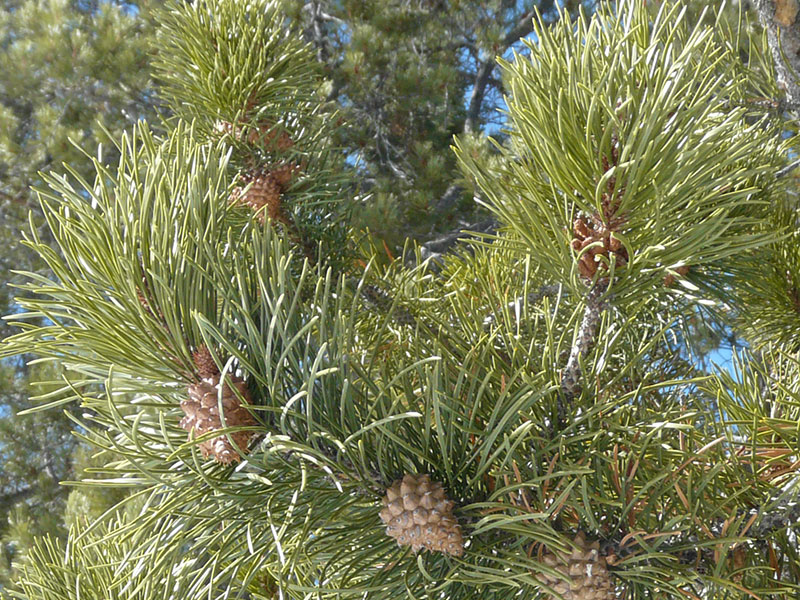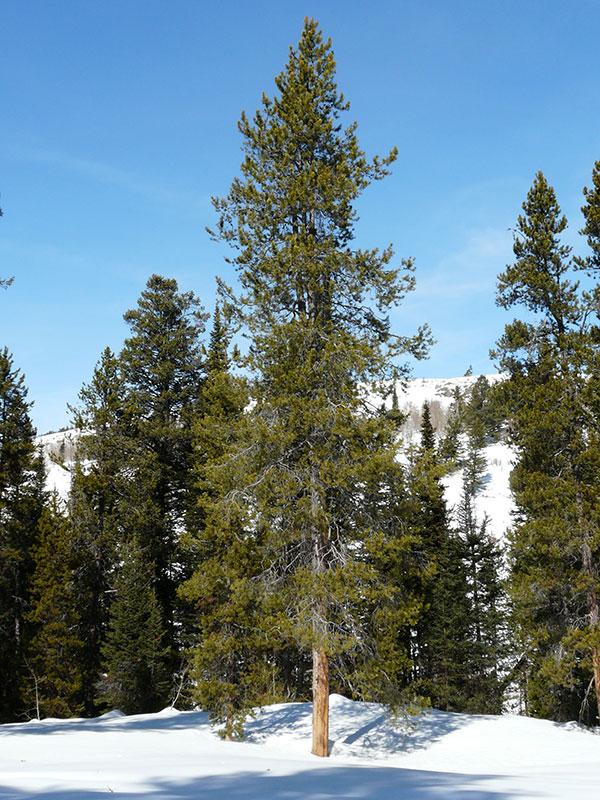Pinus contorta / lodgepole pine
- evergreen conifer
- needles in groups (fascicles) of 2
- lopsided cones, (mostly) remain on tree when mature
- rounded crown; orangey-brown scaly bark
Also known as: shore pine, twisted pine, contorta pine
See also: Pine trees, conifers and evergreens; Pinus flexilis /limber pine
Lodgepole pine is the most common conifer in the northern Rocky Mountains, and certainly in eastern/southeastern Idaho (wherever the Valley is). Like most conifers, and certainly most pines, it is usually identified close-up by its needles. It is also relatively easy to identify from a distance by crown shape, bark color and simply the way it reflects light.
Lodgepole needles vary in color with season (being more yellow in the winter when chloroplasts become disorganized). They come in fascicles of 2, with a retained basal fascicle sheath. They are as much as 3 inches long, or as short as 1.5 inches, and are pointy. They are also twisted, or contorted (being the basis for the Latin specific name). The needles live an average of four to six years. New needles begin to appear in early spring and are mature by early summer. Overall, branches are quite full of needles on short shoots, giving them a full, brushy appearance that stands out at a distance.
The seed cones (i.e. the female cones) of lodgepole pine usually remain attached to the tree after they mature. They are 1 to 3 inches long and have prickles on the scales near the cone apex. The basal scales are more knoblike, and overall, the cones are asymmetrical, i.e. larger on one side than the other near the base. Male cones are found on the same tree, but are separate from the females. They appear as large, orange-red clusters (see gallery photos). Pines are wind pollinated and produce huge quantities of pollen. A Facebook video showing pollen release when a tree is lightly bumped by a front-loader is here. If you have allergies, the video alone might trigger them.
For identification from a distance, the critical feature is a rounded crown with a rather flat top (although in dense forests, the crown is slimmer and more conical, but nothing like a subalpine fir). Once trees have attained some reasonable size, the bark is thin (less than 1/2 inch), orangey-brown to grey, and finely scaled.
As a species, this pine is highly adaptable. It can grow in soils ranging from boggy to dry and sandy. It can occur isolated on a hillside, or as the only tree species in dense “dog-hair” stands of seedlings.
Interesting bits – We live an an area with lots of lodgepole pines. This makes for pretty hillsides, but also indicates potential trouble, particularly the possibility of forest fires. Fire is an essential part of lodgepole ecology, and is also tied up with the ecology of mountain pine beetles and dwarf mistletoe.
Let’s start with the cones. The retention of mature female cones by lodgepole is associated partly with the fact that they are serotinous, meaning they remain closed until they are exposed to high temperatures, particularly from forest fires. Following fire, they open and release their seeds.
Thus, lodgepole is a fire-dependent species; recurring wildfires are essential for establishment and maintenance of healthy populations of diverse ages. The tree structure itself even favors death by fire; the thin-ness of the bark minimizes its defenses when fire strikes. But since most other things also burn, and since lodgepole cones open following fire and release their seeds, lodgepole is able to regenerate quickly and maintain its dominance in the forest habitat.
Interestingly, the mountain pine beetle, while being considered a serious pest by forest managers and the public (dead trees aren’t pretty), fits into this fire scenario. They tunnel under the bark and lay eggs; the larvae feed on the nutrient carrying tissue, the phloem and inner bark (snowshoe hares, voles and squirrels also fed on the inner bark). Thus a beetle infestation can kill large numbers of older trees, leaving behind large amounts of fuel. This increases the possibility of fire, but also pretty much guarantees that the pine will reoccupy the site before other species. Dwarf mistletoe, a parasite of this and other pines, has a similar effect in the long run.
Totally unrelated to this but also quite interesting is the relationship between lodgepole pine and the fungus, Suillus tomentosus. This is one of the ectomycorrhizal fungi and colonizes the particular variety of lodgepole found in the Valley (i.e. var. latifolia). Like all mycorrhizae, these improve the water and phosphorous nutrition of the trees. But these are weird in that they have particular structures which host nitrogen-fixing bacteria. These, in turn, contribute significantly to the nutrition of the trees, allowing them to colonize nutrient-poor sites.
And finally, as some kind of poetic justice or something, lodgepole pine is actually considered an invasive species in New Zealand.
| Family | |
|---|---|
| Inflorescence type | |
| When? | |
| Where? |



